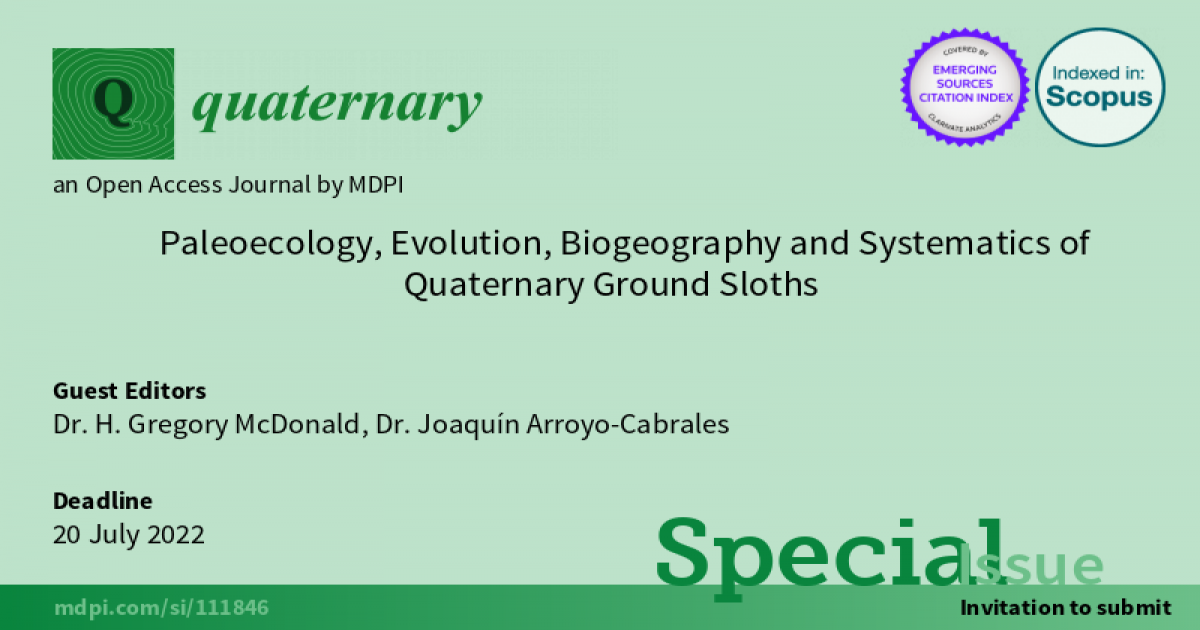- 2.1Impact Factor
- 4.1CiteScore
- 39 daysTime to First Decision
Paleoecology, Evolution, Biogeography and Systematics of Quaternary Ground Sloths
Special Issue Information
Dear Colleagues,
As the title of the volume “Paleoecology, Evolution, Biogeography and Systematics of Quaternary Ground Sloths” indicates, there are only two constraints on the articles submitted, i.e., that the primary taxonomic unit is on an extinct sloth and that it is a taxon from the Quaternary. Within those two parameters, articles that address any aspect of sloth paleoecology using any approach such as stable isotopes, evolutionary aspects of the sloth, distribution and biogeography, and possible causes of extinction of sloths at the end of the Pleistocene are welcome. While broader taxonomic relationships may be addressed, we do not anticipate including the description of new sloth taxa as that may be better addressed in other journals, although functional anatomy as related to the sloth’s ecology is welcome. Information on Quaternary sloths based on trace fossils such as tracks and coprolites is also welcome in the volume. Articles may be narrowly focused on a taxon or locality and may be the first time a specimen or sloth locality is described, or it may be a broader synthesis on one of the above topics as it is applicable to a specific sloth taxon. A diversity of approaches is welcome, and it is hoped that geographically, we can cover all regions from which Quaternary sloths are known.
Thank you for your interest in this volume, and I look forward to seeing your submission.
Dr. H. Gregory McDonald
Dr. Joaquín Arroyo-Cabrales
Guest Editors
Manuscript Submission Information
Manuscripts should be submitted online at www.mdpi.com by registering and logging in to this website. Once you are registered, click here to go to the submission form. Manuscripts can be submitted until the deadline. All submissions that pass pre-check are peer-reviewed. Accepted papers will be published continuously in the journal (as soon as accepted) and will be listed together on the special issue website. Research articles, review articles as well as short communications are invited. For planned papers, a title and short abstract (about 250 words) can be sent to the Editorial Office for assessment.
Submitted manuscripts should not have been published previously, nor be under consideration for publication elsewhere (except conference proceedings papers). All manuscripts are thoroughly refereed through a single-blind peer-review process. A guide for authors and other relevant information for submission of manuscripts is available on the Instructions for Authors page. Quaternary is an international peer-reviewed open access semimonthly journal published by MDPI.
Please visit the Instructions for Authors page before submitting a manuscript. The Article Processing Charge (APC) for publication in this open access journal is 1600 CHF (Swiss Francs). Submitted papers should be well formatted and use good English. Authors may use MDPI's English editing service prior to publication or during author revisions.
Keywords
- paleoecology
- stable isotopes
- extinction
- biogeography
- paleoclimate
- morphology
- trace fossils

Benefits of Publishing in a Special Issue
- Ease of navigation: Grouping papers by topic helps scholars navigate broad scope journals more efficiently.
- Greater discoverability: Special Issues support the reach and impact of scientific research. Articles in Special Issues are more discoverable and cited more frequently.
- Expansion of research network: Special Issues facilitate connections among authors, fostering scientific collaborations.
- External promotion: Articles in Special Issues are often promoted through the journal's social media, increasing their visibility.
- e-Book format: Special Issues with more than 10 articles can be published as dedicated e-books, ensuring wide and rapid dissemination.

